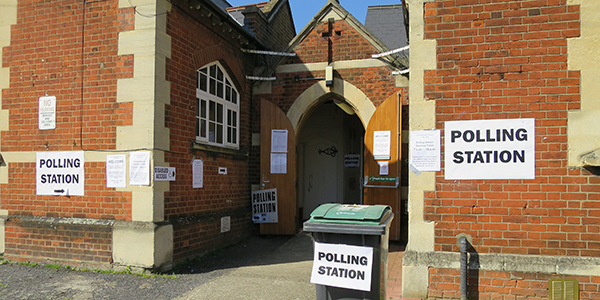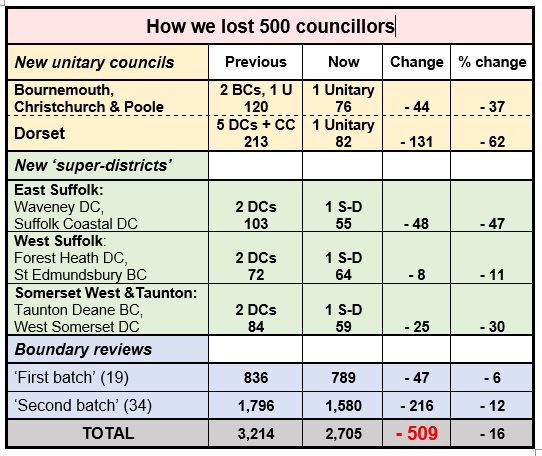Local elections 2019: gone missing – 500 councillors
Local elections are taking place across much of England today, 2 May. However, as Chris Game, explains, the number of local councillors has been reduced in many places, in a reorganisation process that lacks democratic accountability.

Polling Station. Picture: Alan Stanton/(CC BY-SA 2.0) licence
I should have been voting today. I’m a longstanding Birmingham resident, almost unhealthily fascinated by local politics and particularly electoral politics, and it’s one of the years in our electoral cycle when the metropolitan boroughs, like Birmingham, have elections. What more to wish for?
A lot, as it happens – but it involves a quick sprint through recent history, starting in 2014. That was when then Communities and Local Government Secretary, Eric Pickles – and Birmingham City Council Labour Leader, Sir Albert Bore – asked Sir Bob Kerslake, chief DCLG civil servant, to review the city council’s governance and organisational capabilities, with a view to increasing its efficiency and effectiveness.
Sir Bob wasn’t impressed, as his report made starkly clear. The council was dysfunctionally big, visionless and broke, he reckoned, and one perhaps secondary but still significant solution to its bigness was to slash the number of councillors from the then 120, giving each councillor even more residents to deal with, and having them all elected in the same year. Interesting, from an accountant turned career civil servant.
Whereupon the Local Government Boundary Commission piled in, and thought it would be fun to have a mix of one- and two-councillor wards, and changed all the boundaries – confusing electors and predictably reducing the proportion of women councillors all in one go. In case you’re uncertain about the latter assertion, there are currently 27 women councillors in the 32 two-member wards (37%), and just 7 in the 37 one-member wards (19%).
There were protests aplenty, but ministers had spoken, and last May we duly elected our new slimmed-down council. Which is why Birmingham is the only West Midlands metropolitan council with no elections today – the other two non-voting metropolitan councils being Rotherham, which, following its sexual abuses scandal, was required (by Pickles again) to hold all-out elections in 2016 and then every fourth year, and Doncaster, which chose a four-yearly cycle from 2017 to coincide with its mayoral elections.
As you’ll sense, I wasn’t personally terribly enthusiastic about the councillor cull. But nor did I really, to quote Bob Dylan’s deathless Subterranean Homesick Blues, need a weatherman to know which way the wind blows. It was blowing, in seemingly increasingly strong gusts, towards ever larger councils and ever fewer councillors. Resistance seems pointless, and the most I can do is to record the trends for the benefit of those who don’t instinctively realise that where Birmingham leads, others invariably follow.
Every local elections season opens, as it will close, with the incomparable analyses of Colin Rallings and Michael Thrasher. This year, the Local Government Chronicle sub-headlined their preview: ‘The local electoral landscape is undergoing a quiet revolution’. The scale of that revolution was captured by R & T’s opening statistics: whereas four years ago, at the same point in our electoral cycle, more than 9,300 seats were contested in 279 authorities, this week it would be 1,000 fewer seats in 248 authorities.
And the reasons, the causes of the revolution: ‘some councils being merged or abolished, others having their elections cancelled as they await the same fate, and yet others either moving to a new pattern of elections or having often quite sharp reductions in councillor numbers following review by the Local Government Boundary Commission.’
Rallings and Thrasher then went on to their ‘round the grounds’ predictions. I, more nerdily, thought it might be interesting to count the numbers. Some of the ‘1,000 fewer’ seats are easily explained – like the 116 contested four years ago in Birmingham, Doncaster and Rotherham. Others, as noted, are awaiting their fate or changing their electoral cycles. But, by my reckoning, we have actually lost at least 500 seats and councillors – perhaps a dozen councils-worth – since 2014. The Birmingham councillor culling policy is steadily being rolled out across England, but without anyone bothered even to mention, never mind justify, it to us mere voters.
To emphasise: even without change, our councillors have long been expected to represent several times as many constituents as in other European countries, and now, literally year by year, the multiple is increasing as our councillor numbers are steadily cut – through a combination of council mergers and boundary reorganisations.

This year sees the election in Dorset of two new unitary councils in place of the former county, two boroughs, five districts, and a unitary – and a cut in councillor numbers of over half: 333 down to 158. There are also three new ‘super-districts’ in Suffolk and West Somerset, where councillor numbers are reduced by a mere third, from 259 to 178 (see table above). Next year it’s the turn of Buckinghamshire (county council-promoted), Northamptonshire (imposed punishment), and possibly others.
Which brings us to the Local Government Boundary Commissioners, who make all these decisions. They conduct reviews of English local authorities to improve levels of electoral equality, ensuring all councillors represent approximately the same number of electors. But theirs is an odd equality: applying only WITHIN individual authorities, with no comparative reference whatever – even to neighbouring councils.
And here’s the other thing. The commissioners’ statutory criteria include promoting ‘effective and convenient local government’ – but for whom? Do councillors invariably work more effectively if they have responsibility for hundreds more residents? And do these residents always find it more convenient having so many fewer councillors? Because that’s how it almost always works out nowadays.
Today 53 ‘new’ post-review councils are being elected, like Birmingham last year. In the most recent ‘batch’ of 34 reviews, the councils started with 1,796 councillors. Rutland increased its councillor numbers from 26 to 27. The other 33 ended with 217 or 12% fewer – all in the name of more equal, effective and convenient local government. Interesting!
This post represents the views of the author and not those of Democratic Audit.
About the author

Chris Game is an Honorary Senior Lecturer at the Institute of Local Government Studies (INLOGOV) at the University of Birmingham.





 Democratic Audit's core funding is provided by the Joseph Rowntree Charitable Trust. Additional funding is provided by the London School of Economics.
Democratic Audit's core funding is provided by the Joseph Rowntree Charitable Trust. Additional funding is provided by the London School of Economics.
Pah! This loss of 500 councillors in gerrymandering pales to insignificance compared to this blatant bit of dodgy election management:
https://www.newtonsaysno.co.uk/single-post/2019/05/02/TDC-Moves-the-Goalposts-Overnight